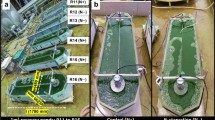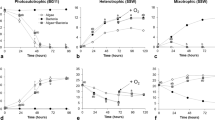Abstract
There is an increasing interest in the use of N2-fixing bacteria for the sustainable biofertilization of crops. Genetically-optimized bacteria for ammonium release have an improved biofertilization capacity. Some of these strains also cross-feed ammonium into microalgae raising additional concerns on their sustainable use in agriculture due to the potential risk of producing a higher and longer-lasting eutrophication problem than synthetic N-fertilizers. Here we studied the dynamic algal cross-feeding properties of a genetically-modified Azotobacter vinelandii strain which can be tuned to over-accumulate different levels of glutamine synthetase (GS, EC 6.3.1.20) under the control of an exogenous inducer. After switching cells overaccumulating GS into a noninducing medium, they proliferated for several generations at the expense of the previously accumulated GS. Further dilution of GS by cell division slowed-down growth, promoted ammonium-excretion and cross-fed algae. The final bacterial population, and timing and magnitude of algal N-biofertlization was finely tuned in a deferred manner. This tuning was in accordance with the intensity of the previous induction of GS accumulation in the cells. This bacterial population behavior could be maintained up to about 15 bacterial cell generations, until faster-growing and nonammonium excreting cells arose at an apparent high frequency. Further improvements of this genetic engineering strategy might help to align efficiency of N-biofertilizers and safe use in an open environment.
Key points
• Ammonium-excreting bacteria are potential eutrophication agents
• GS-dependent deferred control of bacterial growth and ammonium release
• Strong but transient ammonium cross-feeding of microalgae







Similar content being viewed by others
Data availability
Data not included within the manuscript is available upon written request from the corresponding author.
References
Amann E, Ochs B, Abel K-J (1988) Tightly regulated tac promoter vectors useful for the expression of unfused and fused proteins in Escherichia coli. Gene 69(2):301–315. https://doi.org/10.1016/0378-1119(88)90440-4
Ambrosio R, Ortiz-Marquez JCF, Curatti L (2017) Metabolic engineering of a diazotrophic bacterium improves ammonium release and biofertilization of plants and microalgae. Metab Eng 40:59–68. https://doi.org/10.1016/j.ymben.2017.01.002
Bageshwar UK, Srivastava M, Pardha-Saradhi P, Paul S, Gothandapani S, Jaat RS, Shankar P, Yadav R, Biswas DR, Kumar PA, Padaria JC, Mandal PK, Annapurna K, Das HK (2017) An environmentally friendly engineered Azotobacter strain that replaces a substantial amount of urea fertilizer while sustaining the same wheat aield. Appl Environ Microbiol 83(15):e00590–e00517. https://doi.org/10.1128/aem.00590-17
Bali A, Blanco G, Hill S, Kennedy C (1992) Excretion of ammonium by a nifL mutant of Azotobacter vinelandii fixing nitrogen. Appl Environ Microbiol 58(5):1711–1718. https://doi.org/10.1128/aem.58.5.1711-1718.1992
Barney BM (2020) Aerobic nitrogen-fixing bacteria for hydrogen and ammonium production: current state and perspectives. Appl Microbiol Biotechnol 104(4):1383–1399. https://doi.org/10.1007/s00253-019-10210-9
Barney BM, Eberhart LJ, Ohlert JM, Knutson CM, Plunkett MH (2015) Gene deletions resulting in increased nitrogen release by Azotobacter vinelandii: application of a novel nitrogen biosensor. Appl Environ Microbiol 81(13):4316–4328. https://doi.org/10.1128/aem.00554-15
Bloch SE, Ryu M-H, Ozaydin B, Broglie R (2020) Harnessing atmospheric nitrogen for cereal crop production. Curr Opin Microbiol 62:181–188. https://doi.org/10.1016/j.copbio.2019.09.024
Bodirsky BL, Popp A, Lotze-Campen H, Dietrich JP, Rolinski S, Weindl I, Schmitz C, Müller C, Bonsch M, Humpenöder F, Biewald A, Stevanovic M (2014) Reactive nitrogen requirements to feed the world in 2050 and potential to mitigate nitrogen pollution. Nat Commun 5:3858. https://doi.org/10.1038/ncomms4858
Bradford MM (1976) A rapid and sensitive method for the quantitation of microgram quantities of protein utilizing the principle of protein-dye binding. Anal Biochem 72(1):248–254. https://doi.org/10.1016/0003-2697(76)90527-3
Brewin B, Woodley P, Drummond M (1999) The basis of ammonium release in nifL mutants of Azotobacter vinelandii. J Bacteriol 181(23):7356–7362. https://doi.org/10.1128/JB.181.23.7356-7362.1999
Bueno Batista M, Dixon R (2019) Manipulating nitrogen regulation in diazotrophic bacteria for agronomic benefit. Biochem Soc Trans 47(2):603–614. https://doi.org/10.1042/bst20180342
Chen X-P, Cui Z-L, Vitousek PM, Cassman KG, Matson PA, Bai J-S, Meng Q-F, Hou P, Yue S-C, Römheld V, Zhang F-S (2011) Integrated soil–crop system management for food security. Proc Natl Acad Sci U S A 108(16):6399–6404. https://doi.org/10.1073/pnas.1101419108
Colnaghi R, Rudnick P, He L, Green A, Yan D, Larson E, Kennedy C (2001) Lethality of glnD null mutations in Azotobacter vinelandii is suppressible by prevention of glutamine synthetase adenylylation. Microbiology 147(5):1267–1276. https://doi.org/10.1099/00221287-147-5-1267
Conley DJ, Paerl HW, Howarth RW, Boesch DF, Seitzinger SP, Havens KE, Lancelot C, Likens GE (2009) Controlling eutrophication: nitrogen and phosphorus. Science 323(5917):1014–1015. https://doi.org/10.1126/science.1167755
Erisman JW, Galloway JN, Seitzinger S, Bleeker A, Dise NB, Petrescu AMR, Leach AM, de Vries W (2013) Consequences of human modification of the global nitrogen cycle. Philos. Trans. R. Soc. B., Biol. Sci. 368(1621):20130116–20130116. https://doi.org/10.1098/rstb.2013.0116
Fowler D, Coyle M, Skiba U, Sutton MA, Cape JN, Reis S, Sheppard LJ, Jenkins A, Grizzetti B, Galloway JN, Vitousek P, Leach A, Bouwman AF, Butterbach-Bahl K, Dentener F, Stevenson D, Amann M, Voss M (2013) The global nitrogen cycle in the twenty-first century. Philos Trans R Soc Lond B Biol Sci 368(1621):20130164. https://doi.org/10.1098/rstb.2013.0164
Fox AR, Soto G, Valverde C, Russo D, Lagares A Jr, Zorreguieta Á, Alleva K, Pascuan C, Frare R, Mercado-Blanco J, Dixon R, Ayub ND (2016) Major cereal crops benefit from biological nitrogen fixation when inoculated with the nitrogen-fixing bacterium Pseudomonas protegens Pf-5 X940. Environ Microbiol 18(10):3522–3534. https://doi.org/10.1111/1462-2920.13376
Garg SK, Bhatnagar A, Narula N (1998) Application of Azotobacter enhances pond productivity and fish biomass in still water ponds. Aquac Int 6(3):219–231. https://doi.org/10.1023/A:1009254727404
Geddes BA, Ryu M-H, Mus F, Garcia Costas A, Peters JW, Voigt CA, Poole P (2015) Use of plant colonizing bacteria as chassis for transfer of N2-fixation to cereals. Curr Opin Biotechnol 32:216–222. https://doi.org/10.1016/j.copbio.2015.01.004
Herridge DF, Peoples MB, Boddey RM (2008) Global inputs of biological nitrogen fixation in agricultural systems. Plant Soil 311(1):1–18. https://doi.org/10.1007/s11104-008-9668-3
Huisman J, Codd GA, Paerl HW, Ibelings BW, Verspagen JMH, Visser PM (2018) Cyanobacterial blooms. Nat Rev Microbiol 16(8):471–483. https://doi.org/10.1038/s41579-018-0040-1
Johns NI, Blazejewski T, Gomes ALC, Wang HH (2016) Principles for designing synthetic microbial communities. Curr Opin Microbiol 31:146–153. https://doi.org/10.1016/j.mib.2016.03.010
Kaminsky LM, Trexler RV, Malik RJ, Hockett KL, Bell TH (2019) The inherent conflicts in developing soil microbial inoculants. Trends Biotechnol 37(2):140–151. https://doi.org/10.1016/j.tibtech.2018.11.011
Kleinschmidt JA, Kleiner D (1978) The glutamine synthetase from Azotobacter vinelandii: Purification, characterization, regulation and localization. Eur J Biochem 89(1):51–60. https://doi.org/10.1111/j.1432-1033.1978.tb20895.x
Le Moal M, Gascuel-Odoux C, Ménesguen A, Souchon Y, Étrillard C, Levain A, Moatar F, Pannard A, Souchu P, Lefebvre A, Pinay G (2019) Eutrophication: a new wine in an old bottle? Sci Total Environ 651:1–11. https://doi.org/10.1016/j.scitotenv.2018.09.139
Lelieveld J, Evans JS, Fnais M, Giannadaki D, Pozzer A (2015) The contribution of outdoor air pollution sources to premature mortality on a global scale. Nature 525(7569):367–371. https://doi.org/10.1038/nature15371
Moe-Behrens G, Davis R, Haynes K (2013) Preparing synthetic biology for the world. Front Microbiol 4:5. https://doi.org/10.3389/fmicb.2013.00005
Mus F, Crook MB, Garcia K, Garcia Costas A, Geddes BA, Kouri ED, Paramasivan P, Ryu M-H, Oldroyd GED, Poole PS, Udvardi MK, Voigt CA, Ané J-M, Peters JW (2016) Symbiotic nitrogen fixation and the challenges to its extension to nonlegumes. Appl Environ Microbiol 82(13):3698–3710. https://doi.org/10.1128/aem.01055-16
Newton JW, Wilson PW, Burris RH (1953) Direct demonstration of ammonia as an intermediate in nitrogen fixation by Azotobacter. J Biol Chem 204(1):445–451 http://www.jbc.org/
Ortiz-Marquez JCF, Do Nascimento M, Dublan MdlA, Curatti L (2012) Association with an ammonium-excreting bacterium allows diazotrophic culture of oil-rich eukaryotic microalgae. Appl Environ Microbiol 78(7):2345–2352. https://doi.org/10.1128/aem.06260-11
Ortiz-Marquez JCF, Do Nascimento M, Zehr JP, Curatti L (2013) Genetic engineering of multispecies microbial cell factories as an alternative for bioenergy production. Trends Biotechnol 31(9):521–529. https://doi.org/10.1016/j.tibtech.2013.05.006
Ortiz-Marquez JCF, Do Nascimento M, Curatti L (2014) Metabolic engineering of ammonium release for nitrogen-fixing multispecies microbial cell-factories. Metab Eng 23:154–164. https://doi.org/10.1016/j.ymben.2014.03.002
Plunkett MH, Knutson CM CM, Barney BM (2020) Key factors afecting ammonium production by an Azotobacter vinelandii strain deregulated for biological nitrogen fxation. Microb Cell Factories 19:107. https://doi.org/10.1186/s12934-020-01362-9
Rockström J, Steffen W, Noone K, Persson Å, Chapin Iii FS, Lambin EF, Lenton TM, Scheffer M, Folke C, Schellnhuber HJ, Nykvist B, de Wit CA, Hughes T, van der Leeuw S, Rodhe H, Sörlin S, Snyder PK, Costanza R, Svedin U, Falkenmark M, Karlberg L, Corell RW, Fabry VJ, Hansen J, Walker B, Liverman D, Richardson K, Crutzen P, Foley JA (2009) A safe operating space for humanity. Nature 461:472–475. https://doi.org/10.1038/461472a
Rockström J, Williams J, Daily G, Noble A, Matthews N, Gordon L, Wetterstrand H, DeClerck F, Shah M, Steduto P, de Fraiture C, Hatibu N, Unver O, Bird J, Sibanda L, Smith J (2017) Sustainable intensification of agriculture for human prosperity and global sustainability. Ambio 46(1):4–17. https://doi.org/10.1007/s13280-016-0793-6
Rosenblueth M, Ormeño-Orrillo E, López-López A, Rogel MA, Reyes-Hernández BJ, Martínez-Romero JC, Reddy PM, Martínez-Romero E (2018) Nitrogen fixation in cereals. Front Microbiol 9:1794–1794. https://doi.org/10.3389/fmicb.2018.01794
Ryu M-H, Zhang J, Toth T, Khokhani D, Geddes BA, Mus F, Garcia-Costas A, Peters JW, Poole PS, Ané J-M, Voigt CA (2020) Control of nitrogen fixation in bacteria that associate with cereals. Nat Microbiol 5(2):314–330. https://doi.org/10.1038/s41564-019-0631-2
Santos KFDN, Moure VR, Hauer V, Santos ARS, Donatti L, Galvão CW, Pedrosa FO, Souza EM, Wassem R, Steffens MBR (2017) Wheat colonization by an Azospirillum brasilense ammonium-excreting strain reveals upregulation of nitrogenase and superior plant growth promotion. Plant Soil 415(1):245–255. https://doi.org/10.1007/s11104-016-3140-6
Savage E, Nagle N, Laurens LML, Knoshaug EP (2020) Nitrogen derived from combined algal processing supports algae cultivation for biofuels. Algal Res 50:101987. https://doi.org/10.1016/j.algal.2020.101987
Smanski MJ, Zhou H, Claesen J, Shen B, Fischbach MA, Voigt CA (2016) Synthetic biology to access and expand nature's chemical diversity. Nat Rev Microbiol 14(3):135–149. https://doi.org/10.1038/nrmicro.2015.24
Smith MJ, Francis MB (2016) A designed A. vinelandii–S. elongatus coculture for chemical photoproduction from air, water, phosphate, and trace metals. ACS Synth. Biol. 5(9):955–961. https://doi.org/10.1021/acssynbio.6b00107
Smith MJ, Francis MB (2018) Methods for generating microbial cocultures that grow in the absence of fixed carbon or nitrogen. In: Braman JC (ed) Synthetic biology: methods and protocols. Springer, New York, pp 45–60
Smith VH, Schindler DW (2009) Eutrophication science: where do we go from here? Trends Ecol. Evol. 24:201–207. https://doi.org/10.1016/j.tree.2008.11.009
Stadtman ER, Smyrniotis PZ, Davis JN, Wittenberger ME (1979) Enzymic procedures for determining the average state of adenylylation of Escherichia coli glutamine synthetase. Anal Biochem 95:275–285. https://doi.org/10.1016/0003-2697(79)90217-3
Sutton MA, Oenema O, Erisman JW, Leip A, van Grinsven H, Winiwarter W (2011) Too much of a good thing. Nature 472(7342):159–161. https://doi.org/10.1038/472159a
Tripathy PP, Ayyappan S (2005) Evaluation of Azotobacter and Azospirillum as biofertilizers in aquaculture. World J Microbiol Biotechnol 21(8):1339–1343. https://doi.org/10.1007/s11274-005-3787-2
Waltz E (2017) A new crop of microbe startups raises big bucks, takes on the establishment. Nat Biotechnol 35:1120–1122. https://doi.org/10.1038/nbt1217-1120
Zhang T, Yan Y, He S, Ping S, Alam KM, Han Y, Liu X, Lu W, Zhang W, Chen M, Xiang W, Wang X, Lin M (2012) Involvement of the ammonium transporter AmtB in nitrogenase regulation and ammonium excretion in Pseudomonas stutzeri A1501. Res Microbiol 163(5):332–339. https://doi.org/10.1016/j.resmic.2012.05.002
Acknowledgements
The authors are very thankful to Dr. Ortiz-Marquez (Boston College, MA, USA) for critical reading of the Ms. R. A. and L.C. are doctoral fellows and career researchers at the CONICET, Argentina, respectively.
Funding
This research was funded by the Agencia Nacional de Promoción Científica y Tecnológica, Argentina [grant numbers PICT2015-3559 and PICT2018-3382] to L.C.
Author information
Authors and Affiliations
Contributions
L.C. conceived the project, provided funding, designed the experiments, analyzed the results, provided overall guidance, and wrote the paper. R.A. designed some experiments, executed all the experiments, analyzed the results, and helped to prepare the draft manuscript. Both authors revised the manuscript and approved it for submission.
Corresponding author
Ethics declarations
Ethical approval
This article does not contain any studies with human participants or animals performed by any of the authors.
Conflict of interest
The authors declare no competing interests.
Additional information
Publisher’s note
Springer Nature remains neutral with regard to jurisdictional claims in published maps and institutional affiliations.
Supplementary Information
ESM 1
(PDF 362 kb)
Rights and permissions
About this article
Cite this article
Ambrosio, R., Curatti, L. Deferred control of ammonium cross-feeding in a N2-fixing bacterium-microalga artificial consortium. Appl Microbiol Biotechnol 105, 2937–2950 (2021). https://doi.org/10.1007/s00253-021-11210-4
Received:
Revised:
Accepted:
Published:
Issue Date:
DOI: https://doi.org/10.1007/s00253-021-11210-4




